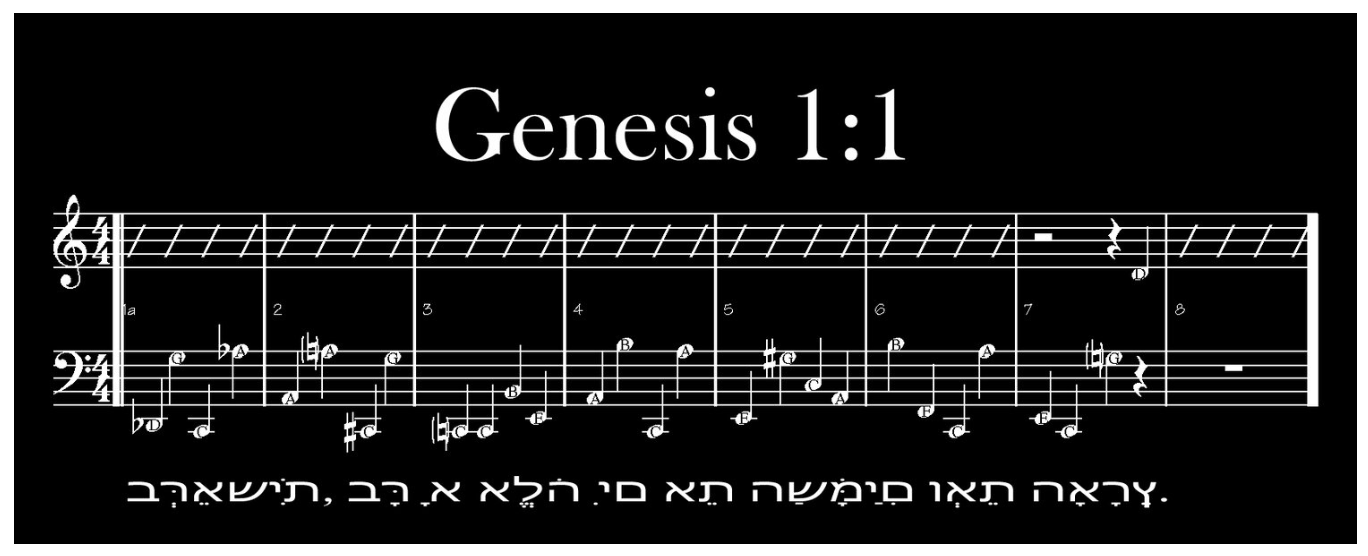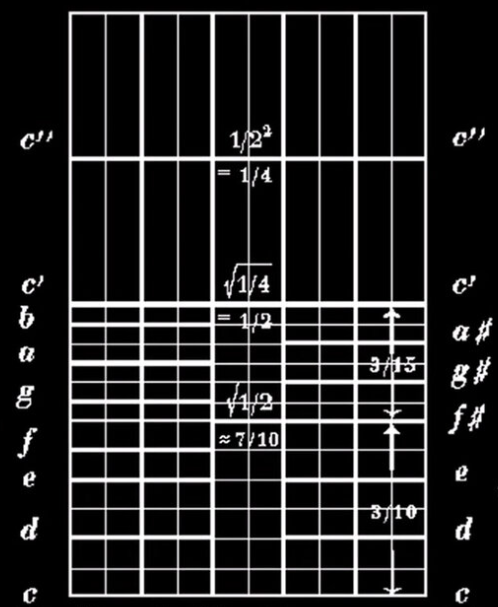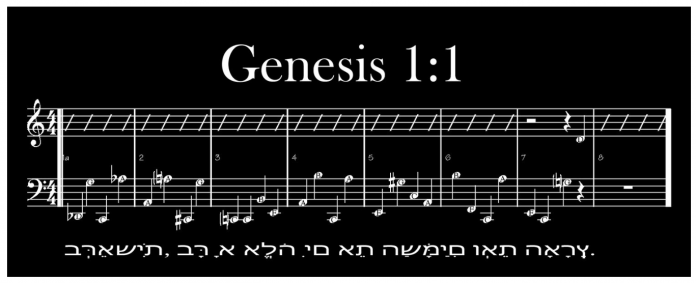To celebrate the start of our reading of Bereishis, I made this video using some interesting musical observations and some “creative visualization.” I hope you enjoy listening and watching. (The subtle choir is performed by the Mercury Children’s Choir (boys). There is no issur of Kol Eisha).
What Is It?
The melody is formed by the sequence of the letters of the first posuk in Bereishis. In the video, in the lower right corner, you will see each letter appear as it’s musical note is played.
The composition was created by mapping the complete Aleph-Beit of 27 letters to the notes of the musical scale and composing an orchestral harmony based on the interrelationship of the actual melody using the accepted rules of orchestration.
I created the orchestration based on the exact melody derived from the letters of the posuk to illustrate my emotional response to the results. At no point is the derived melody from the sequence of letters in the posuk altered as you can see by the appearance of the letters as they unfold. To visually illustrate my reaction I composed a video, which is based on my own “creative imagination” and not to suggest that the video is a representation of what actually took place. Although this is referenced in the Gemara, (below*), I make no claim that my video is a representation. I did have in mind some ideas from Chazal, such as the universe being created using the Alef-Bet and the literal sequence of events as described in the posuk.
*The Gemara brings teachings of the Sages that touch on these areas of study. One example is the dispute between Beit Shammai and Beit Hillel about the order of creation. Beit Shammai argues (based on the passage in Bereishis 1:1) that the shamayim – the sky, or firmament – was created before the earth, while Beit Hillel points to a later pasuk (Bereishis 2:4) that seems to indicate that it was the earth that was created before the heavens. Beit Hillel also argues from a logical perspective, that the attic of a house is built only after the foundation and building are complete (see Amos 9:6), while Beit Shammai views the heavens as God’s chair and the earth as His footrest (see Yeshayahu 66:1), and argues that the chair should precede the footrest. A compromise position is laid out by the Hakhamim, who point to another passage in Sefer Yeshayahu (48:13) as indicating that the heavens and earth were created simultaneously. One explanation of this position is that the heavens and earth can be compared to a clay pot and its cover that are placed in the furnace so that they will harden. It is only if they are placed in the furnace together that the potter can be certain that the cover will be a perfect fit to the finished pot.
The Idea Behind It
As I mentioned above, I suggest that our musical scale was actually derived from the measurements of the Luchos as received by Moshe Rabbenu in 1441 B. C. E.
The Luchos (Tablets) of the Torah form a horizontal division into fifteenths and a vertical division of tenths and fifteenths which results in an accurate formula where the each of the Tablets of the Law is calculated by the 60 Manah weight-stones; 6 vertical and 10 horizontal lines as described in the Torah.
In music, there are 5 basic chord variations (or in musical terms; modes) of each scale which yields a total of 60 chords when multiplying the twelve tones that make up each musical scale (5×12). The measurements of the Luchos, when mapped as sound frequencies yield all the notes (tones) of the musical scale.
The Traditional Belief of the Origin of the Scale
The current musical scale system is credited to Pythagoras, a Greek philosopher and mathematician who lived around 550 B.C.E. Legend has it that Pythagoras listened to the blacksmith’s hammer striking the anvil and discovered the tones produced by the hammering was related to the weight of hammer, and to his great surprise, the weights came in simple whole number ratios to each other. Unfortunately, this is a mathematical fallacy massaged by Pythagoras to “sound pleasing to the ear”. When played together, he arrived at the conclusion that the sounds fit in simple ratios to each other as notes. According to modern physics, his formula turns out to be incorrect and is not so simple. While it sounds nice, it does not take into consideration the entire 12 tones of the scale, including the black notes (on the piano), but only the simple 8 notes of the octave (white notes). However, the divisions of the Luchos yield the exact frequencies of all of the musical notes in full accordance with modern physics.
The following illustrations show the correlation between the letters and their corresponding notes in the composition and the measurements of the Tablets to obtain them. The Hebrew verse is shown left to right (backwards) to correspond to musical notation which is written left to right.




Fascinating! My husband (is a web designer) told me to set the browser magnification to 250% and to click on the gear icon on the bottom and set it to 1080p. It gets a much bigger and clearer image. Very moving. How many hats can one Ron wear? Bravo.
Very interesting, greatly enjoyed. thank you!
I thought you might also mention fascinating similarities with the visual/numerical side of things, based on Fibonacci sequence / Golden ratio in the same Passuk א.
(Feel free to PM or email me for this information)
Sounds very interesting! Please contact me via TLS and we can connect. There is so much in that Posuk! The Malbim gets deep into it. I have a set of his Sforim elaborating at great length just on Bereishis, which sadly are now out of print.